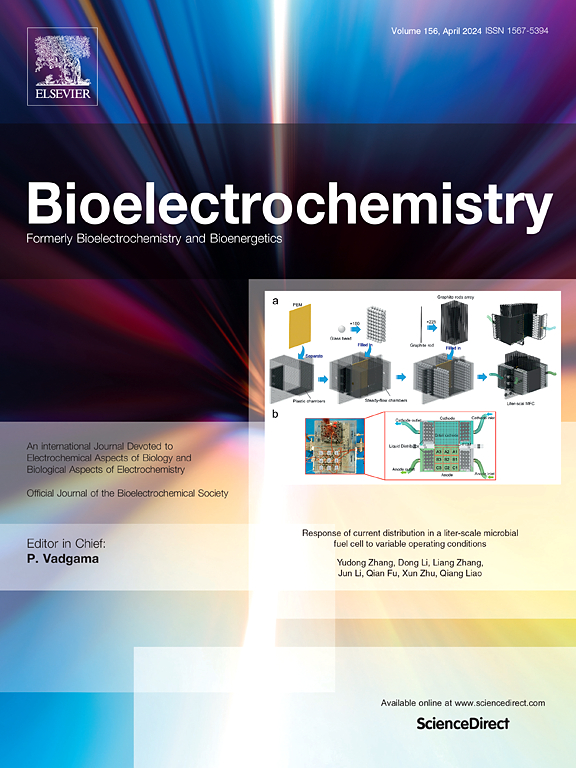Electrodeposition of carbon nanotubes and conjugation of arginyl-glycyl-aspartic acid for the following of glioblastoma cells on bionanocomposites
IF 4.8
2区 化学
Q1 BIOCHEMISTRY & MOLECULAR BIOLOGY
引用次数: 0
Abstract
The improvement of surface treatment methods that permit the tuning of cell adhesion on the surface of biomaterials and devices is of considerable importance. Here, multi-walled carbon nanotubes (MWCNT) were modified with 4-aminothiophenol (4ATP). Then, electrodeposition of MWCNT-4ATP was carried out on 4ATP-modified screen-printed gold electrodes (SP-Au). After conjugation of Arginyl-glycyl-aspartic acid (RGD)-peptide on Poly(MWCNT-4ATP), the adhesion of U-87MG glioblastoma cells was examined by differential pulse voltammetry (DPV) technique. The synthesized MWCNT-4ATP and the obtained Poly(MWCNT-4ATP)/RGD surfaces were characterized using Scanning Electron Microscopy-Energy Dispersive X-Ray Spectrometer (SEM-EDS), Attenuated Total Reflection Fourier Transform Infrared Spectroscopy (ATR-FTIR), X-Ray Photoelectron Spectrometer (XPS). The linear range for U-87MG glioblastoma cells was 102–106 cells/mL. The developed Poly(MWCNT-4ATP)/RGD cell adhesion platform provided monitoring of U-87MG glioblastoma cells using DPV technique and fluorescent imaging.
电沉积碳纳米管及精氨酸-甘氨酸-天冬氨酸在生物纳米复合材料上对胶质母细胞瘤细胞的结合
表面处理方法的改进,使细胞粘附在生物材料和器件表面的调整是相当重要的。本文采用4-氨基噻吩(4ATP)修饰多壁碳纳米管(MWCNT)。然后,在4atp修饰的丝网印刷金电极(SP-Au)上电沉积MWCNT-4ATP。采用差分脉冲伏安法(DPV)检测精氨酸酰甘氨酸-天冬氨酸(RGD)肽在Poly(MWCNT-4ATP)上偶联后U-87MG胶质母细胞瘤细胞的粘附情况。采用扫描电镜-能谱仪(SEM-EDS)、衰减全反射傅里叶变换红外光谱(ATR-FTIR)、x射线光电子能谱仪(XPS)对合成的MWCNT-4ATP和得到的Poly(MWCNT-4ATP)/RGD表面进行了表征。U-87MG胶质母细胞瘤细胞的线性范围为102 ~ 106个细胞/mL。所建立的Poly(MWCNT-4ATP)/RGD细胞黏附平台利用DPV技术和荧光成像技术监测U-87MG胶质母细胞瘤细胞。
本文章由计算机程序翻译,如有差异,请以英文原文为准。
求助全文
约1分钟内获得全文
求助全文
来源期刊

Bioelectrochemistry
生物-电化学
CiteScore
9.10
自引率
6.00%
发文量
238
审稿时长
38 days
期刊介绍:
An International Journal Devoted to Electrochemical Aspects of Biology and Biological Aspects of Electrochemistry
Bioelectrochemistry is an international journal devoted to electrochemical principles in biology and biological aspects of electrochemistry. It publishes experimental and theoretical papers dealing with the electrochemical aspects of:
• Electrified interfaces (electric double layers, adsorption, electron transfer, protein electrochemistry, basic principles of biosensors, biosensor interfaces and bio-nanosensor design and construction.
• Electric and magnetic field effects (field-dependent processes, field interactions with molecules, intramolecular field effects, sensory systems for electric and magnetic fields, molecular and cellular mechanisms)
• Bioenergetics and signal transduction (energy conversion, photosynthetic and visual membranes)
• Biomembranes and model membranes (thermodynamics and mechanics, membrane transport, electroporation, fusion and insertion)
• Electrochemical applications in medicine and biotechnology (drug delivery and gene transfer to cells and tissues, iontophoresis, skin electroporation, injury and repair).
• Organization and use of arrays in-vitro and in-vivo, including as part of feedback control.
• Electrochemical interrogation of biofilms as generated by microorganisms and tissue reaction associated with medical implants.
 求助内容:
求助内容: 应助结果提醒方式:
应助结果提醒方式:


